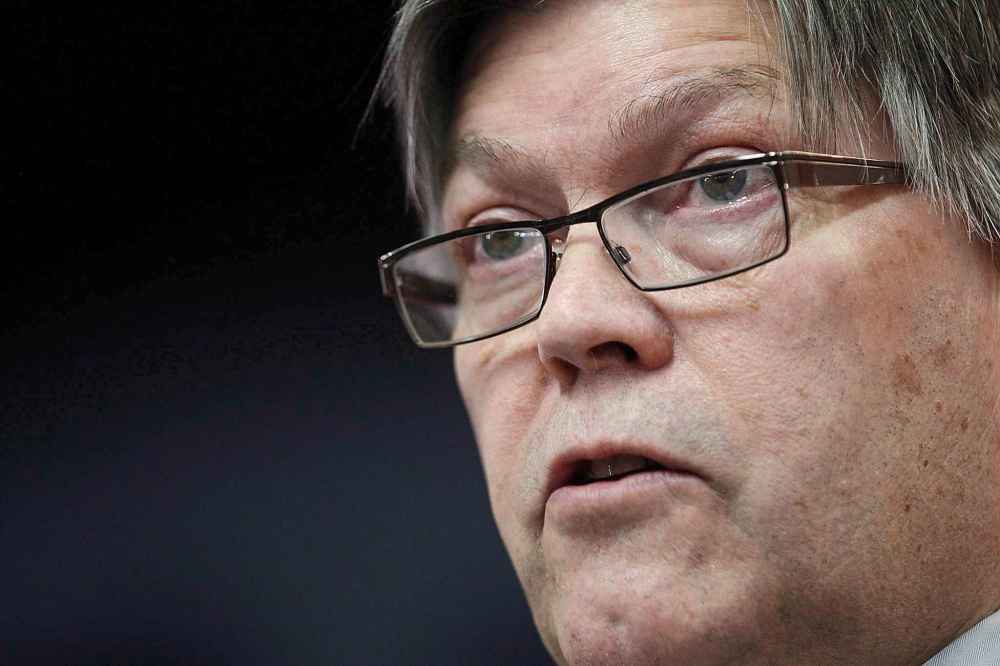Welcome to the Wishart School of Hard Knocks With teachers' contracts expiring in two weeks and implementation of wage-control measures awaiting court action, Manitoba's education minister is promising drastic action to fix a broken, underperforming public-school system
Read this article for free:
or
Already have an account? Log in here »
To continue reading, please subscribe:
Monthly Digital Subscription
$0 for the first 4 weeks*
- Enjoy unlimited reading on winnipegfreepress.com
- Read the E-Edition, our digital replica newspaper
- Access News Break, our award-winning app
- Play interactive puzzles
*No charge for 4 weeks then price increases to the regular rate of $19.00 plus GST every four weeks. Offer available to new and qualified returning subscribers only. Cancel any time.
Monthly Digital Subscription
$4.75/week*
- Enjoy unlimited reading on winnipegfreepress.com
- Read the E-Edition, our digital replica newspaper
- Access News Break, our award-winning app
- Play interactive puzzles
*Billed as $19 plus GST every four weeks. Cancel any time.
To continue reading, please subscribe:
Add Free Press access to your Brandon Sun subscription for only an additional
$1 for the first 4 weeks*
*Your next subscription payment will increase by $1.00 and you will be charged $16.99 plus GST for four weeks. After four weeks, your payment will increase to $23.99 plus GST every four weeks.
Read unlimited articles for free today:
or
Already have an account? Log in here »
Hey there, time traveller!
This article was published 12/06/2018 (2744 days ago), so information in it may no longer be current.
Premier Brian Pallister’s government has spent more than two years dismantling and reassembling Manitoba’s health-care system in a drastic attempt to rein in runaway costs.
Next up, public education.
The province is taking control of spending in a $2.4-billion system that has, largely, been run locally since the days of one-room schoolhouses. Manitoba’s share of the funding — about $1.4 billion — depends on a complex formula calculated over dozens of categories, based largely on enrolment and the assessed values of properties.

Education Minister Ian Wishart has increased operating grants by 0.5 per cent, the lowest since the 1990s, and clawed back more cash than he’s put into schools. He’s ordered a 15 per cent cut in administration and plans to amend the Public Schools Act to take away trustees’ bargaining powers and allow provincewide contract negotiations with teachers.
Manitoba is the last province in Canada in which school boards have taxing power — trustees have been free to levy whatever property taxation they believe their children need to get a quality education or — from a more cynical perspective — how much homeowners will stand to pay. But equity in public education depends enormously on the serendipity of arbitrary school division borders and the relative affluence of homeowners living within them, as well as the concentration of tax-paying commercial and industrial properties.
A minority of the province’s 37 divisions are home to the vast majority of commercial properties. St. James-Assiniboia has proportionally far more commercial properties than Seven Oaks; Pembina Trails enjoys the taxes paid by IKEA and all the big-box stores on Kenaston Boulevard that don’t add a single child to its classrooms, while the Winnipeg School Division can afford all its so-called social engineering programs because of taxes paid by downtown office towers and Polo Park and Grant Park shopping centres.
Meanwhile, house prices are rising much faster than the value of business properties, so homeowners are covering an increasing percentage of the tax burden.
Wishart will launch a comprehensive review of the entire system late this year — he doesn’t like to hear it called a value-for-money audit — that will include a complete overhaul of the funding formula to to educate 187,036 kids more equitably.
What will that look like when the dust settles?
"That’s the million-dollar question," said Ken Cameron, president of the Manitoba School Boards Association. "It begs the question of what their intentions are going forward, of the status of local boards, of taxation powers."
!function(e,t,n,s){var i=”InfogramEmbeds”,o=e.getElementsByTagName(t)[0],d=/^http:/.test(e.location)?”http:”:”https:”;if(/^/{2}/.test(s)&&(s=d+s),window[i]&&window[i].initialized)window[i].process&&window[i].process();else if(!e.getElementById(n)){var a=e.createElement(t);a.async=1,a.id=n,a.src=s,o.parentNode.insertBefore(a,o)}}(document,”script”,”infogram-async”,”https://e.infogram.com/js/dist/embed-loader-min.js”);
The Tories have rejected arguments in favour of small class sizes and have made clear their disdain for bloated administration. The government’s stated priorities are improving literacy and numeracy.
"We need to do it right," Wishart said, adding nothing is off the table. "This is the most important change in a generation."
Wishart capped school boards’ property tax increases at two per cent for the budgets passed March 15, thus stifling the other remaining vestige of autonomous power trustees could wield in the past.
Teachers’ salaries account for the biggest piece of the public-education budget. With court-challenged Bill 28 freezing salaries for two years and banning any improvements in benefits and working conditions if they involve money, what’s left to bargain?
Salary increments, for one. The long-entrenched and accepted grid by which new teachers gain salary bumps each year for their first decade or so of work will be targeted, Wishart said.
Cameron said the province and educators are on a high-speed collision course that could lead to talk of strikes and lockouts after more than 50 years of peace.
"It doesn’t leave much, does it?" he said of the wage and benefit freeze. "Very rarely do they give up anything they’ve got.
Bargaining with teachers
It’s an understatement to say that issues surrounding collective bargaining — the biggest single cost in the education system — are mired in confusion.
Wishart has said he plans to table an amendment to the Public Schools Act to introduce provincewide bargaining, which would be conducted under Bill 28’s wage controls.
However, he hasn’t yet tabled the amendment, let alone had it passed, and teachers’ 37 collective bargaining agreements expire June 30.
The Manitoba Teachers’ Society has long said it favours provincial bargaining, but now the union is outraged that the Tories didn’t consult teachers before making the move. MTS argues that with the amendment not in effect, and Bill 28 not yet proclaimed, its 37 bargaining units have been giving notice to their divisions that they’re ready to bargain normally over wage increases and improvements to benefits.
School trustees have feared losing bargaining control, even though they’ve settled for identical wage increases the past two CBAs, with some local bargaining over working conditions. School boards have watched their authority erode.
Wishart says that each one per cent not paid to teachers under Bill 28 saves school divisions $13.1 million. This year teachers received two 1.5-per-cent raises four months apart, following three years of two-per-cent annual increases.
MTS is part of a 25-union coalition awaiting a court decision on its request for an injunction to block Bill 28 until its constitutional challenge can be heard, which could take years. School divisions say they need to set aside money for retroactive pay increases if the courts throw out Bill 28, but the Tories have capped their reserve funds and school divisions don’t have any money to set aside, anyway.
Property taxes
For years, the NDP threatened to cap school property taxes, but instead left trustees — who’d bear the brunt of homeowners’ anger — holding the bag while the province quietly maintained its share at the level of provincial growth.
The money collected via property taxes had risen between 4.76 per cent and 6.1 per cent during the last four years. Now Wishart has capped it at two per cent, about $21.9 million.
Cameron said that school boards haven’t crunched the numbers to see how much they’re paying for teachers’ increments.
As for saving $13.1 million for every one per cent teachers are denied, "I don’t believe it’s as high as they’re estimating."

Cutting administration
The government has ordered school divisions to implement lower administration cost caps for the 2018-19 school year at the division level, including the trustees and their boards, at three per cent for urban boards of more than 5,000 students, 3.6 per cent for those under 5,000 and 4.25 per cent in the North. The lower caps are the same 15 per cent administration cuts Pallister ordered throughout the civil service, health care and Crown corporations.
The divisional administration cost is $83.3 million, which is 3.5 per cent of overall revenue — the number-crunching works out to $2.1 million worth of jobs that will be eliminated in 20 of the 37 divisions now above the new caps, Wishart said.
Of course, those people can’t be shown the door without hefty buyouts and severance, which will take a year or more to come off the books. And in many divisions, there aren’t enough senior people to cut.
"We’ve had caps before," Cameron said. "If you go too far with administration, it makes it tough to run things. You need someone to run the school buses, someone to run human resources."
Amalgamation
It’s 24 years since the provincial government received and buried the Norrie Report, which recommended the then-57 school divisions be reduced to 21. Winnipeg would have been carved into four divisions more or less by the Red and Assiniboine rivers. Wishart said he’s been studying the report.
In 2002, without having previously mentioned the possibility, the NDP government chopped the number of divisions to 37, without using any clear criteria. Small divisions of 1,500 or fewer students with low assessment bases were left untouched. Winnipeg and Seven Oaks remained whole, but other city divisions were forced together or saw large parts merged with rural divisions, which were similarly ripped asunder or forced together.
Some Canadian cities, including Toronto, have moved to a single division . Winnipeg still has seven, including the St. Norbert portion of Seine River, and there are four trustees in the provincewide Division Scolaire Franco-Manitobaine. There are 59 school trustees elected within Winnipeg’s city limits.
"The most common comment is, why do you have so many?" said Wishart.
Provincial officials caution that there’s a limit to how large rural divisions can grow before they cover too much area to operate effectively, but every rural division has one or more neighbours. And up north, Flin Flon, Kelsey in The Pas and Mystery Lake in Thompson are far from affluent and surrounded by Frontier School Division. The three combined have barely more than the average assessment per student throughout Manitoba.
The NDP never did explain how McCreary-based Turtle River, with fewer students — 721 — than most urban high schools, remained a stand-alone division in 2002. There are currently 11 divisions smaller than the province’s largest high schools.
Clawing back
For four years ending in 2011, the NDP offered a tax-incentive grant, extra cash rewarding school boards that froze their property taxes at the previous year’s level. Qualifying for the bonus money was a complicated affair, but once a division got the cash, it became part of the base funding, regardless of how much trustees jacked up taxes the following year.
That pot has sat at $61.4 million since 2011. Wishart will claw all of it back over six years, starting off with $7.5 million this year.
Last year he clawed back a chunk of the formula guarantee, but there’s still $20.6 million sitting there. That’s another NDP invention, money that ensured a school division with enrolment drops and assessment changes wouldn’t receive a penny less than the year before, regardless of what the formula determined the division deserved to get.
Then there’s the $41.3 million Farmland School Tax Rebate paid out every year since its implementation in 2004. The rebate increased from 33 per cent that year 2004 to 80 per cent in 2016.
And finally, there’s the gargantuan $343.3-million education property tax credit, which knocks up to $700 off homeowners’ and tenants’ property tax bills. The municipal tax credit had been around for decades, but in 2005 the NDP thought it politically beneficial to suddenly label it as government largesse reducing increasingly-onerous school property taxes.
The cash
Overall spending on the $2.4-billion public education system has been going up $60 million to $80 million a year, with the burden slowly but inexorably shifting from the province to property owners.
Wishart’s increase in operating grants of 0.5 per cent and $6.6 million is the lowest since the 1990s. He’s clawed back $7.5 million from tax incentive grants. The money collected from property taxes is now capped at two per cent, about $21.9 million. Freezing teachers’ wages would save $26.2 million, assuming "normal" raises of two per cent. Cutting administration 15 per cent shaves off another $2.1 million.
With teachers’ salaries frozen, the net increase in revenue would be $19.8 million, which would have to be enough to cover new teacher and other staff hires, teachers’ incremental raises if they survive intact, maintenance, repairs, heating and other energy costs, water and sewage, bus transportation, information technology, supplies, elections and every other conceivable expenditure.
But there’s always more. Even if every single expenditure remains fixed at last year’s level, there’s an enrolment increase of 1,647 children with an average operating cost of $13,187 per student. That’s more than $21.7 million in new spending.
The obvious consequence? Funding per student declines.
nick.martin@freepress.mb.ca







